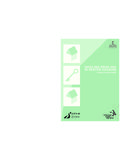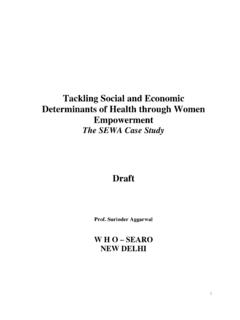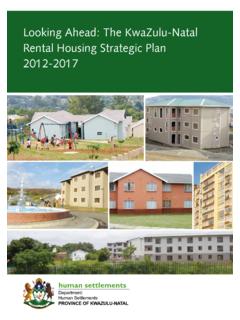Transcription of 2017 Annual Review of Social Housing - Beever …
1 2017 Annual Review of Social Housing 2017 Annual Review of Social Housing 2017 Annual Review of Social Housing Contents executive Summary .. 1 Value for money .. 4 Governance .. 11 Risk and regulation .. 16 Property sales .. 20 Rent arrears .. 21 Capital commitments .. 23 Non-regulated activities reporting .. 25 Bonds, borrowing and derivatives .. 27 FRS 102 - Housing properties .. 29 FRS 102 - Errors and other adjustments .. 32 FRS 102 - Pensions .. 35 FRS 102 - Financial Instruments .. 37 Glossary .. 40 2017 Annual Review of Social Housing PAGE 1 executive Summary Introduction Welcome to the latest Beever and Struthers Review of Social Housing . We discuss the accounts and Annual reports of the largest 100 Registered Providers (RPs) (Top 100) published in the 2015/16 reporting season.
2 We also discuss a number of topical issues including taking a look at FRS 102 implementation. The headlines from each section are highlighted below: Value for money (VfM) The Accounting Direction for Private Registered Providers of Social Housing in England 2015 requires RPs to make a statement regarding VfM in their Board report or Strategic Report. We note that whilst VfM reporting is still of variable quality, VfM benchmarking is now common practice and more RPs now provide a return on assets and plans of how to deal with underperforming assets. Analysis of cost per unit data is clearly going to be high on the agenda for the sector for the coming years and Boards need to develop an understanding of where they sit in relation to their peers. Governance We have reviewed the composition of Boards once again and look at how payments to Board Members and governance have been reported.
3 Of particular interest we note that the number of Top 100 RPs which pay non- executive board members increased from 79% in 2015 to 89% in 2016 whilst total remuneration paid to non- executive board members increased to in 2016 from in 2015. The NHF Code of Governance states that Boards should have at least five members and no more than 12, including any co-optees and any executive board members. As last year, 95% of RPs had between five and 12 Board Members. Risk and regulation The handling of risk continues to be a hot topic for the Homes and Communities Agency (HCA). Risks detailed in the Board reports within the Top 100 have significantly changed this year although welfare reform remains the most commonly identified risk with 73 of the Top 100 raising it as a risk.
4 Brexit is a new entry in the top ten with 39 raising it as a risk and both Government policies and Regulation are raised by significantly more RPs this year. The HCA has issued 19 regulatory downgrade judgements in 2015/16 and, outside of the Top 100, failure to submit financial statements within six months was the most common reason for a regulatory notice. Property sales Total property sales by the Top 100 have increased significantly this year, amounting to 855m compared to 585m in 2015. As you would probably expect, seven of the top ten highest total surpluses from sales in the year recorded by the Top 100 were from London and South East England. We note that only four of the Top 100 made a deficit on their first-tranche sales in the year.
5 Rent arrears Gross arrears across the Top 100 have increased in the year by , from 694m to 711m. This is interesting, suggesting that the feared impact of welfare reform and universal credit have not fully yet materialised. In addition, the aggregate bad debt provision has fallen by , from 325m to 318m. Capital commitments Our Review shows that capital commitments increased by in 2015/16 compared to in 2014/15. Once again there are large discrepancies between the levels of authorised but not contracted commitments, mirroring the differences of disclosure of units in development. As expected the larger South-East based RPs have the largest capital commitments reflecting their shared ownership and outright sales programmes. 2017 Annual Review of Social Housing PAGE 2 executive Summary Non-regulated activities reporting Non-regulated activities reporting remains an area of increasing focus for the HCA as the sector continues to diversify into a range of new commercial ventures and relationships, through unregulated subsidiaries, joint ventures and special purpose vehicles.
6 Of particular interest we note that non- Social Housing activities contribute of total turnover ( ) and building for sale income of 1,291m contributes of non- Social Housing turnover. This increasing diversity into non-regulated activities results in regulatory concerns around the importance of not putting Social Housing assets at risk; and protecting the public value in those assets. Bonds, borrowings and derivatives Reported facilities for the sector have increased to 80bn, of which 18% was undrawn. The maturity profile of existing debt means that refinancing risk is low, 86% of debt being due for repayment in more than five years. The use of long term fixes, through bonds, fixed rate bank debt or interest rate swaps continues to provide the sector with a degree of certainty on forecasting the costs of borrowing.
7 Bond issues and private placements contributed only 34% of total new finance raised, the lowest percentage of new facilities from capital market funding since 2011, primarily due to uncertainty in the sector and the need to reassess business plans following the rent cut in the July 2015 budget. FRS 102 - Housing properties The introduction of FRS 102, supported by the 2014 Housing SORP and the 2015 Accounting Direction was the biggest change to the accounting regime in a long time. Our Review looks at how the Top 100 have dealt with these changes. With regards to Housing properties we note that only three of the Top 100 account for Housing properties at valuation, compared to 11 in 2015. In addition, the transition exemption allowing a valuation of an item of property, plant and equipment to be used as deemed cost was popular, with 25 RPs applying this.
8 It is also interesting to note that impairment remains an important issue in the sector. FRS 102 - Errors and other adjustments FRS 102 requires that if an entity becomes aware of errors made under its previous accounting framework, the transition reconciliation note shall distinguish the correction of those errors from changes in accounting policy. Our Review identified 16 RPs within the Top 100 that reported prior period adjustments in 2015/16 other than FRS 102 adjustments. FRS 102 - Pensions New requirements under FRS 102 in relation to accounting for the Social Housing Pension Scheme (SHPS) past service deficit arrangements have added significant liabilities to the balance sheets of the Top 100, amounting to 685m at 31 March 2016.
9 Our Review identified 76 of the Top 100 RPs which reported servicing a SHPS past service deficit as at 31 March 2016. In addition we note that within the Top 100, 25 RPs had a past service deficit in place greater than 10m recognised in the Statement of Financial Position. FRS 102 - Financial instruments The application of FRS 102 added an additional of financial liabilities to the balance sheets of the Top 100 as at 31 March 2015. 53 RPs reported complex financial instruments in the 31 March 2016 financial statements, 45 of which held derivatives and eight of which held other non-basic loans. 2017 Annual Review of Social Housing PAGE 3 executive Summary Key: Throughout the document we have used the following symbols to draw attention to matters of particular interest: = example of individual best practice.
10 = example of generic bad practice/failure to meet regulations. = something to note or watch out for. 2017 Annual Review of Social Housing PAGE 4 Value for Money Key points: Value for Money (VfM) reporting is still of variable quality. VfM benchmarking is now common practice. More RPs now provide a return on assets and plans of how to deal with underperforming assets. Introduction The Accounting Direction for Social Housing in England 2015 requires RPs to make a statement regarding VfM in their board report or Strategic Report. This is set out in paragraph 8. It provides no guidance, however, as to the form of this statement. The HCA issued a new Economic Standard with effect from 1 April 2012 which covers governance and viability, rent and VfM. RPs boards are required to demonstrate to stakeholders that they meet the standards.










